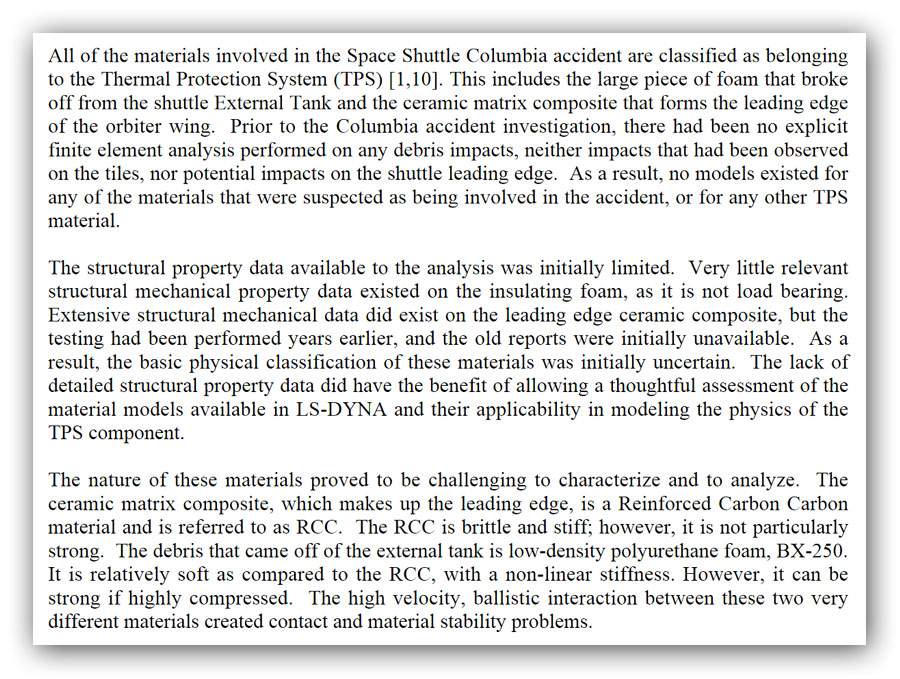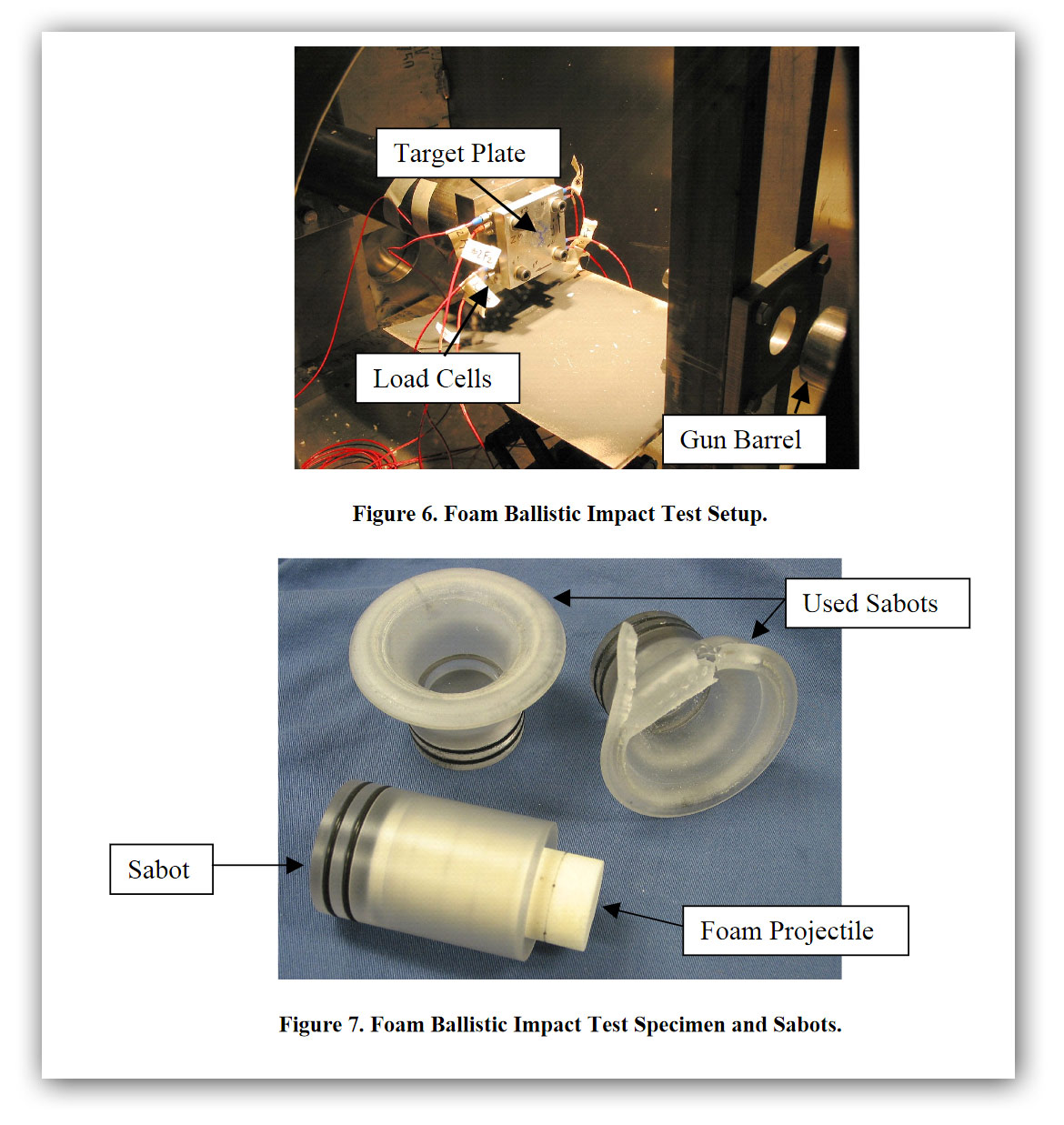I met Matt Melis at a USENIX around 2005; he did a talk on system reliability engineering that started with “my job is to shoot supersonic bullets at diamonds.”
He headed up the research project that was trying to figure out where the error bars were on the chunk of heat shielding that hit the leading edge of the space shuttle Columbia – was that a freak accident, or was that something that would more or less always happen if the shuttle got hit? It turned out to be a really interesting question that, I now believe (from googling around) pretty much became his career for about 14 years afterward. They were doing things like building cannon that could throw supersonic gobs of ice at $250,000 carbon/carbon space shuttle wing leading edge-pieces. He brought one of the pieces to his talk, and passed it around – it was a large, black, heavy-looking thing of solid reinforced carbon/carbon. If I recall, it’s basically carbon cement around carbon fibers, sort of like the fiberglass reinforcement in a surfboard, except lighter and way more expensive. It was surreally light for something so hard and dense-looking.
His talk was fascinating and it made a lot of us software guys think long and hard about how casually we took for granted the consequences of our code. Real failure analysis, fault analysis and correction are a life and death matter – software is about the only field where “oh, hey, the servers are unreachable” or “the code crashed, let’s push a patch” are accepted practice. Part of the stress we feel in computer security is that feeling of growing up and slowly taking responsibility for understanding outcomes – which we generally don’t.

So, a whole model for foam, and how it behaves, under various circumstances needed to be developed. And with most things to do with high speeds, there are all sorts of non-linearities. He showed us some videos of supersonic ice-blocks hitting the wing segment “now, watch – where does it go?” it just disappears – turns in to gas. But it turned out that another piece of carbon/carbon hitting it made a neat hole – very stiff materials hitting very stiff materials makes holes.

I can’t explain it very well but it was all fascinating stuff. There’s a talk by Melis (basically, the one he gave at USENIX) on youtube, if you like – but that’s not what I’m going to encourage you to watch. [youtube]
He finished by saying that he had access to all kind of footage regarding the launch, and had assembled some of it just because he thought it was cool. And he thought that was a better way to remember the space shuttle. So he played this: [If you are impatient you can jump to 2:40]

I’ve been posting a bit on the “light and fluffy” side because I’m so depressed about what’s going on in the world that it’s hard to get out of bed some mornings. Thinking about the beautiful and interesting things humans do is how I distract myself.
Back in the late 90s I wound up at a dinner party talking to a fellow who was one of the chief photographers for NASA. Now, there’s another pretty amazing job. We had a great big old camera geek-out about the kind of stuff that he did and then he said something that I will never forget: “See, because of my job, I can pretty much go down to the machine-shop guys and ask them for anything and they’ll just nod and schedule it.” It turns out that to get footage like the stuff above, you need specialized camera-boxes that can handle being near 3 million horsepower of energy blasting right near them. They use stuff like machined titanium boxes that completely contain all the gear, which have synthetic sapphire lens-shields, and are bolted to the gantry. From the way he described it, one of the achievements he was most proud of was setting up an 8×10 camera in a bolted-down armored box, perfectly positioned with the exposure calculated just so, and he got an incredible negative of a perfect still of a shuttle going up. It became one of the official pictures that was used in a bunch of places, including being blown up to monster size [you can blow up an 8×10 negative to something ludicrous if you have those kind of resources] We spent a while nerding out over the difficulty of predicting the exposure for a gigantic fire-pluming rocket at dawn, and getting the negative so nothing blows out and he said casually, “well, space shuttle launches all tend to produce the same amount of light, so you get the exposure dialed in pretty well.” All nerdgasms aside, it’s an interesting challenge, photographically – but NASA’s got people who can meet it.

No, sloppy work happens in pretty much every field that I know something about. Consider graphic design, for example. If a graphic designer makes a mistake while putting together the digital file that will be used for printing a newspaper, the result can be thousands of dollars wasted on printed paper that will be thrown out. For this reason, it makes sense that graphic designers ought to be careful. Except that many of them aren’t. I have seen all sort of sloppy work done by other graphic designers.
By the way, last time I hired a plumber, I ended up with crooked and weirdly bent water pipes in my home. They weren’t leaking, so he considered it a job well done.
Aw, that’s sad. I’m sending you a hug.
I haven’t had to deal with feeling depressed for ages (last time happened before I realized that boyfriends are easily replaceable), but focusing on the beautiful and happy things in life is also how I keep myself cheerful. The thing is, human life can be extremely enjoyable, there are so many fun activities to do, so many interesting things to learn about. And then there’s also art. It’s perfectly possible to just not think about all the bad things.
This one sounds extremely interesting; the technical aspects of photography can give me nerdgasms as well. It seems for me like you have been lucky to meet some interesting people, which, incidentally, is another reason to be happy about life.
You’re right that sloppy work is very, very common. Space travel is the main field, though, where one mistake can doom lives and multi-million-dollar pieces of equipment. Given that, it’s amazing we’ve had as few accidents as we have.
Actually, lots of events in aeronautics too can result in lives and multi-million dollar pieces of equipment being lost. And yet commercial air transport is amazingly safe. Same goes for civil and mechancial engineering, to a greater or lesser degree depending on what’s being built. Nor is it amazing that we have relatively few accidents with these things; the risk levels are carefully calculated and chosen with enough precision that we should be expecting exactly the number of failures we get.
I don’t find it weird that some plumbers do sloppy work; they’re not in general doing life-criticial systems and they don’t call themselves engineers. (And when they do deal with, say, plumbing for gas lines they’re following standards developed by engineers.)
I am coming around to the idea that there is, or at least can be, a sort-of engineering component to software design, I still am annoyed by people calling themselves or others “software engineers” when they bring basically no rigour at all to the process of developing software.
That was amazing and mesmerizing. I couldn’t look away. Thanks.
I tend to say that “software engineering” is in roughly the same state of development as architecture was during the great cathedral building boom of the 13th and 14th centuries – we have some great ideas, but basically no idea how to implement them properly, and the stuff we build has a nasty habit of collapsing unexpectedly, often before it’s even finished. I very much doubt that anything we build will last as long though…